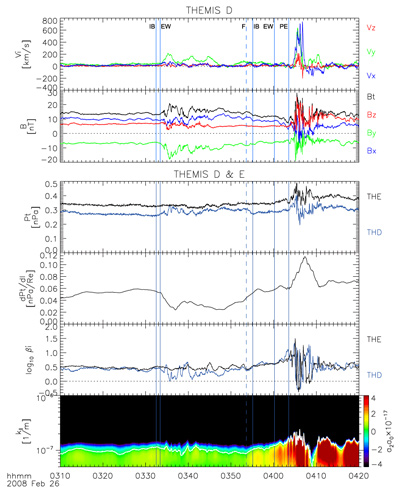
2018 THEMIS SCIENCE NUGGETS
A case study of near-Earth magnetotail conditions at substorm and pseudosubstorm onsets
by Yukinaga Miyashita
Korea Astronomy and Space Science Institute
Introduction
A pseudosubstorm, also called pseudobreakup, is an auroral phenomenon very similar to a substorm, but essentially differs in absence of active auroral poleward expansion. To understand what makes this difference or what suppresses further development of poleward expansion for the pseudosubstorm, we studied conditions of the near-Earth magnetotail at the beginning of these auroral phenomena on the basis of concurrent THEMIS all-sky imager and multispacecraft observations. This comparison is expected to give us some clues to understanding of substorm triggering and development mechanisms.
| Figure 1. Auroral images showing (upper panels) the present pseudobreakup and (lower panels) the subsequent substorm on 26 February 2008, along with footprints of the THEMIS B, C, D, and E spacecraft and the GOES 10 and 12 spacecraft. |
Results
Figure 1 shows that after initial auroral brightening, the onset arc gradually extended westward and eastward with its wave-like structure growing for both pseudosubstorm and substorm. The onset arc then subsided without progressing to poleward expansion for the pseudosubstorm, while poleward expansion or auroral breakup began for the substorm.
| Figure 2. THEMIS D and E observations of the near-Earth magnetotail during the pseudosubstorm and the substorm on 26 February 2008. (upper panels) The ion velocity and the magnetic field from THEMIS D. (lower panels) The total (ion plus magnetic) pressure, the total pressure gradient in the direction from THEMIS D toward THEMIS E, the ion β, and the equivalent growth rate of ideal magnetohydrodynamics drift ballooning instability (Pu et al., 1997) from THEMIS D and E. The vertical blue lines from the left to the right indicate the times of initial auroral brightening (IB) and enhancement of the wave-like structure (EW) of the pseudobreakup, auroral fading (F, dashed line), and initial brightening, enhancement of the wave-like structure, and poleward expansion (PE) of the substorm. |
Figure 2 shows that in the near-Earth magnetotail, the northward (positive) magnetic field Bz was larger just before the pseudosubstorm than just before the substorm, indicating that magnetic field lines were less stretched just before the pseudosubstorm. Dipolarization (persistent increase in the northward Bz) did not occur for the pseudosubstorm, whereas it began just before poleward expansion for the substorm. The ion β, the total (ion plus magnetic) pressure, and the total pressure gradient derived from the two closely located spacecraft of THEMIS D and E were smaller around the pseudosubstorm initial brightening than around the substorm initial brightening.
We also attempted to estimate the growth rate of ballooning instability. The growth rate (positive below the white line) was smaller for the pseudosubstorm than for the substorm and increased more and more after each of the three auroral steps for the substorm. This suggests that near-Earth magnetotail conditions, such as the pressure gradient and the ion β, affect whether ballooning instability grows sufficiently to lead to full-fledged dipolarization and auroral poleward expansion.
Conclusion
We found that plasma and magnetic field conditions in the near-Earth magnetotail differed between the pseudosubstorm and substorm onsets. In particular, the pressure gradient and the ion β were smaller for the pseudosubstorm than for the substorm. This finding implies that near-Earth magnetotail conditions possibly affect whether the initial action develops into a full-fledged substorm.
More detailed cause and effect relationship between near-Earth magnetotail conditions, dipolarization, pseudosubstorms, and substorms needs further statistical and theoretical studies. Besides the near-Earth magnetotail conditions, the effects of near-Earth magnetic reconnection and the ionosphere on pseudosubstorms and substorms are also future studies.
Reference
Miyashita, Y., Angelopoulos, V., Fukui, K., and Machida, S. (2018). A case study of near-Earth magnetotail conditions at substorm and pseudosubstorm onsets. Geophysical Research Letters, 45, 6353-6361. https://doi.org/10.1029/2018GL078589Pu, Z. Y.,et al. (1997). MHD drift ballooning instability near the inner edge of the near-Earth plasma sheet and its application to substorm onset. Journal of Geophysical Research, 102(A7), 14,397-14,406. https://doi.org/10.1029/97JA00772
Biographical Note
Yukinaga Miyashita is a senior researcher at Korea Astronomy and Space Science Institute in Daejeon, South Korea. His research interests include substorm triggering mechanism, the magnetotail, and aurora.
 Please send comments/suggestions to
Emmanuel Masongsong / emasongsong @ igpp.ucla.edu
Please send comments/suggestions to
Emmanuel Masongsong / emasongsong @ igpp.ucla.edu


